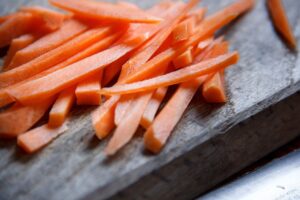How Ferment Carrots

Discover the joy of fermenting carrots! It’s simple, nutritious, and adds a unique tangy flavor to your meals. All you need are fresh carrots, salt, water, and a bit of patience. Learn how to ferment carrots today and enjoy the probiotic-rich goodness!
Fermenting Carrots
Fermenting carrots is a simple process that requires just a few ingredients and tools. This
Ingredients:
- Fresh carrots
- Salt
- Filtered water
- Optional: garlic, dill, peppercorns or other spices for added flavor
Supplies Needed to Ferment Carrots
- A clean, large glass jar with a lid
- A smaller jar or weight to keep the carrots submerged
- A sharp knife and cutting board
How to Choose the Right Carrots to Ferment
When choosing the right carrots, it’s crucial to opt for organic ones if possible, as they are free from harmful pesticides. The carrots should be fresh, firm, and vibrant in color, indicating their freshness and nutritional value. Avoid carrots that are limp or have black spots. If the carrots come with tops, they should be bright green and not wilted. Stick to medium-sized carrots as they are easier to handle and fit into jars.

Preparing the Jars for Fermenting Carrots
Preparing the jars is essential to ensure the vegetables stay submerged in the brine during fermentation. It’s crucial to wash and sterilize all equipment thoroughly before use. To sterilize, soak the jars, lids, and weights in boiling water for a few minutes, then let them air dry.
Alternatively, you can use a dishwasher with a sanitizing cycle to clean the jars or put them in the oven set at 375 ℉ for 10 minutes.
How to Prepare the Carrots:
- Start by washing and scrubbing the carrots thoroughly.
- Cut off the tops of the carrots if still attached.
- Slice or cut the carrots to your desired size and shape, whether it’s coins, sticks, or whole.
- Optional: Add garlic cloves, dill sprigs, peppercorns, or other spices to enhance flavor and add variety.
- Pack the carrots tightly into a jar, leaving about an inch of space at the top.
Making the Brine for Fermenting Carrots
What salt is best for Fermenting carrots
When it comes to fermenting carrots, the best salt to use is non-iodized sea salt. This type of salt contains natural minerals that are beneficial for fermentation, unlike iodized table salt, which may contain anti-caking agents that can interfere with the process.
Sea salt or Kosher salt that is finely ground is best. Coarse salt is hard to accurately measure and takes longer to dissolve.
It’s important to avoid using salt substitutes or low-sodium salt as they may not have the necessary minerals and can result in a weaker brine, leading to a less successful fermentation process.
Experiment with different salts and find what works best for you, but keep in mind that non-iodized sea salt is generally considered the top choice for ferment
It’s recommended you do your brine by weight 30 gm salt to 1L water to make a 3% solution. You will need enough brine to cover all the carrots in the jar, so it’s better to prepare more than less.
Since I use cups and tsp after a lot of web searching, to make a 3% brine, you will need about 1.8 teaspoons of salt per cup of water. This ratio is important to maintain the proper pH level for fermentation and prevent harmful bacteria from growing, but our ancestors did this without scales. Still, if you want to be absolutely sure of your brine percentage you have to weigh. You can adjust the amount of salt depending on your taste preferences, but it’s essential to always have at least a 2% brine solution for carrots.
To prepare the brine:
- In a container, mix 4 cups of water with 1.8 tsp(I would just use 2 tsp) of sea salt per cup until fully dissolved this will result in percentage a of 2-3% brine which is what is recommended for carrots.
- Pour the brine over the packed carrots in the jar, leaving about ½ inch of space at the top.
- Add more water if necessary to ensure all carrots are fully submerged.
What Percentage Brine is Best for Carrots?
A 3% brine is generally recommended for fermenting carrots, which means using 30 gm tablespoon of sea salt per liter of water. This ratio ensures that the fermentation process will occur without promoting harmful bacteria growth. However, some people prefer a more salty taste and use a higher percentage brine.
Packing the jars
It’s essential to pack the jars tightly with carrots to avoid any air pockets that can lead to spoilage. You can use a wooden spoon or your hands (after thoroughly washing them) to push down on the carrots and ensure they are tightly packed.
Adding a Fermentation Weight
After adding the brine, it’s essential to keep the carrots submerged in the solution to prevent any mold or harmful bacteria from growing on the surface. You can use a fermentation weight, such as a small glass jar filled with water, to push down on the carrots and keep them fully submerged. Alternatively, you can also use a cabbage leaf or even a Ziplock bag filled with brine.
Adding Brine as Needed
During the fermentation process, some brine may evaporate due to the release of carbon dioxide. It’s essential to check on your jars regularly and add more brine if necessary to ensure that the carrots stay fully submerged.
Covering and Storing the Jar
Once the jar is filled and ready, it’s time to cover it. Though fermenting carrots can produce a strong smell, it’s essential to remember that fermentation is an anaerobic process, meaning it happens in the absence of air. Therefore, cover the jar with a tight lid, ensuring there are no gaps. The key is to ensure that the carrots stay submerged under the brine. It can be a glass weight or simply a baggie of brine. This allows gases to escape while preventing contaminants from getting in. This article belongs to pineyriverhomestead.com published 10-11-23
How Should You Cover Your Fermenting Jar
During the fermentation process, gases are produced that need to be released. Therefore, if you are using a tight sealing lid you should cover your fermenting jar in a way that allows these gases to escape. One popular method is using an airlock lid, available at many home brewing stores or online. This tool allows gases to escape from the jar without letting air or contaminants in. Alternatively, you can burp your jars once a day.
How to “Burp” Your Fermenting Jar and Why
“Burping” your fermenting jar is the process of briefly opening the jar to release built-up gases. This is especially important if you’re not using an airlock lid. To “burp” your jar, simply unscrew the lid a bit to allow the gases to escape, then tighten it back down. This prevents pressure from building up in the jar, which could potentially lead to the jar exploding. Always burp with care, as the contents may fizz and overflow. Regularly “burping” your jar (every 1-2 days) during the initial days of fermentation is crucial to ensure a smooth fermentation process.

Fermentation Time
The fermentation time for carrots can vary depending on various factors such as temperature, salt percentage, and personal preference. However, generally, carrots will need to ferment for about 1-2 weeks at a room temperature of around 60-70°F (15-21°C). It’s important to remember that the warmer your environment, the faster the fermentation will occur. Therefore, you’ll need to check your ferment regularly – once every few days should suffice. If you prefer a stronger, more tangy flavor, feel free to let your carrots ferment for a longer period. Be aware that over-fermentation can lead to mushy carrots, so it’s a delicate balance to strike.
How do you know when the carrots are fermented?
There are a few ways to tell when your carrots are fully fermented. One sign is that the brine will become cloudy and there may be some bubbling activity. Another indicator is the smell – you’ll notice a distinctive, slightly sour aroma. Additionally, taste testing your carrots can also give you an idea of how far along they are in the fermentation process. If they have a pleasant tang and crunch, they’re likely ready to be consumed. However, if they still taste too salty or not sour enough, give them a few more days to ferment. It’s always better to err on the side of caution and let your carrots ferment for longer rather than ending up with under-fermented vegetables.
Do fermented carrots taste different?
Yes, fermented carrots do have a distinct taste compared to raw or cooked carrots. The fermentation process enhances the natural flavors of carrots and adds a tangy, slightly sour note. Some people describe the taste as more complex and intense, making it an enjoyable addition to dishes. Additionally, fermenting carrots also increases their nutritional value by boosting probiotic content and breaking down difficult-to-digest compounds, making them more beneficial for gut health. Lastly, fermenting carrots also extends their shelf life, so you can enjoy them for longer without the risk of spoilage. So if you’re looking to add a new dimension to your carrot dishes and improve their nutritional value, give fermented carrots a try!
How do you know if your fermented carrots need to be discarded?
There are a few signs that indicate your fermented carrots have gone bad and need to be discarded. The first is the appearance – if you notice any mold growth or sliminess on the carrots, it’s best to throw them out. In addition, a foul or unpleasant smell is also an indication of spoilage. If the brine is discolored or has a strong vinegar smell, it’s also a sign that the fermentation process did not go as planned. Finally, if you taste the fermented carrots and they have an off-putting or unpleasant flavor, it’s best to discard them. Trust your senses and err on the side of caution when consuming fermented foods to avoid any potential food safety issues. Remember, it’s better to start over
Storing Your Fermented Carrots
To prolong the shelf life of your fermented carrots, it’s important to store them properly. You can keep your fermented carrots in the refrigerator for 3 months perhaps longer. Let your nose and eyes be your guide. Discard if in doubt. Make sure they are fully submerged in brine and tightly sealed in a jar or container. Just make sure to check on them periodically and discard any that show signs of spoilage. Enjoy your homemade fermented carrots as a tasty and nutritious addition to your meals!
Cooking with Fermented Carrots
Fermented carrots can be used in various dishes to add a tangy and unique flavor. They can be added to salads, sandwiches, or even blended into a dip or dressing. You can also use them as a topping for tacos or in stir-fry dishes. The possibilities are endless! Additionally, you can incorporate the brine from the fermented carrots into marinades or sauces for an extra boost of flavor. Get creative and experiment with different ways to incorporate fermented carrots into your cooking. Your taste buds will thank you! Happy fermenting and happy cooking! Happy fermenting and happy cooking!
Conclusion
Fermenting carrots is a fun and easy way to add a nutritional boost to your diet while also reducing food waste. With just a few simple steps, you can create delicious and nutritious fermented carrots that can be enjoyed in a variety of ways. Remember to always follow safety guidelines and use proper storage methods to ensure the best quality and taste. So why not give it a try and start fermenting your own carrots today? Happy fermenting! Happy cooking! And happy eating! Enjoy the tangy, probiotic-rich goodness of homemade fermented carrots.
Note: This content is for informational purposes only and should not be considered medical advice. As always, consult with your healthcare provider before making any changes to your diet.
For more on fermenting vegetable click here.
